Deck 10: Quasi-Experimental Design
Question
Question
Question
Question
Question
Question
Question
Question
Question
Question
Question
Question
Question
Question
Question
Question
Question
Question
Question
Question
Question
Question
Question
Question
Question
Question
Question
Question
Question
Question
Question
Question
Question
Question
Question
Question
Question
Question
Question
Question
Question
Question
Question
Question
Question
Question
Question
Question
Question
Question
Question
Question
Question
Question
Question
Question
Question
Question
Question
Question
Question
Question
Question
Question
Question
Question
Question
Question
Question
Question

Unlock Deck
Sign up to unlock the cards in this deck!
Unlock Deck
Unlock Deck
1/70
Play
Full screen (f)
Deck 10: Quasi-Experimental Design
1
Figure TB 10-1
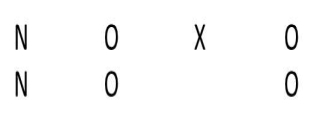
What type of design is shown above?
A)non-equivalent groups
B)regression discontinuity
C)proxy-pretest
D)separate pre-post samples

What type of design is shown above?
A)non-equivalent groups
B)regression discontinuity
C)proxy-pretest
D)separate pre-post samples
A
2
A pre-post quasi-experimental research design where the treatment is given to only one unit in the sample,with all remaining units acting as controls is a ____ design.
A)double pretest
B)switching replications
C)nonequivalent dependent variables
D)regression point displacement
A)double pretest
B)switching replications
C)nonequivalent dependent variables
D)regression point displacement
D
3
In experimental design notation,the letter C stands for ____.
A)continuity
B)covariate
C)control
D)cut-off
A)continuity
B)covariate
C)control
D)cut-off
D
4
In what type of design are the people who receive the pretest are not the same as the people who take the posttest?
A)non-equivalent groups
B)regression discontinuity
C)proxy-pretest
D)separate pre-post samples
A)non-equivalent groups
B)regression discontinuity
C)proxy-pretest
D)separate pre-post samples

Unlock Deck
Unlock for access to all 70 flashcards in this deck.
Unlock Deck
k this deck
5
The regression-discontinuity design is very susceptible to selection bias.

Unlock Deck
Unlock for access to all 70 flashcards in this deck.
Unlock Deck
k this deck
6
The fundamental threat to internal validity in the nonequivalent groups design is selection.

Unlock Deck
Unlock for access to all 70 flashcards in this deck.
Unlock Deck
k this deck
7
In the proxy-pretest design,the pretest is collected after the program is given.

Unlock Deck
Unlock for access to all 70 flashcards in this deck.
Unlock Deck
k this deck
8
Figure TB 10-1

What type of design is a pre-post two-group quasi-experimental design structured like a pretest-posttest randomized experiment,but lacks random assignment to groups?
A)non-equivalent groups
B)regression discontinuity
C)proxy-pretest
D)separate pre-post samples

What type of design is a pre-post two-group quasi-experimental design structured like a pretest-posttest randomized experiment,but lacks random assignment to groups?
A)non-equivalent groups
B)regression discontinuity
C)proxy-pretest
D)separate pre-post samples

Unlock Deck
Unlock for access to all 70 flashcards in this deck.
Unlock Deck
k this deck
9
What type of design is a post-only design in which,after the fact,a pretest measure is constructed from preexisting data?
A)non-equivalent groups
B)regression discontinuity
C)proxy-pretest
D)separate pre-post samples
A)non-equivalent groups
B)regression discontinuity
C)proxy-pretest
D)separate pre-post samples

Unlock Deck
Unlock for access to all 70 flashcards in this deck.
Unlock Deck
k this deck
10
If there is a difference between the pretest scores of the intervention and comparison groups in the NEGD,it indicates that there is selection bias.

Unlock Deck
Unlock for access to all 70 flashcards in this deck.
Unlock Deck
k this deck
11
With respect to internal validity,quasi-experiments often appear to be inferior to randomized experiments.

Unlock Deck
Unlock for access to all 70 flashcards in this deck.
Unlock Deck
k this deck
12
Although the participants in some quasi-experimental designs can be individuals or groups of individuals,in regression-discontinuity studies,they can only be individuals.

Unlock Deck
Unlock for access to all 70 flashcards in this deck.
Unlock Deck
k this deck
13
When the nonequivalent groups design is used,the groups are almost always as similar as they would have been had there been random assignment.

Unlock Deck
Unlock for access to all 70 flashcards in this deck.
Unlock Deck
k this deck
14
One of the most important contributors to the development of quasi-experimental design is ____.
A)Edwin Thurstone
B)Donald T. Campbell
C)R.A. Fisher
D)John Tukey
A)Edwin Thurstone
B)Donald T. Campbell
C)R.A. Fisher
D)John Tukey

Unlock Deck
Unlock for access to all 70 flashcards in this deck.
Unlock Deck
k this deck
15
Quasi-experiments are often preferable when it would be unethical to randomly assign individuals to treatment conditions.

Unlock Deck
Unlock for access to all 70 flashcards in this deck.
Unlock Deck
k this deck
16
There are ____ possible outcomes in a non-equivalent groups design.
A)two
B)three
C)four
D)five
A)two
B)three
C)four
D)five

Unlock Deck
Unlock for access to all 70 flashcards in this deck.
Unlock Deck
k this deck
17
A two-group design in two phases defined by three waves of measurement is a ____ design.
A)double pretest
B)switching replications
C)nonequivalent dependent variables
D)regression point displacement
A)double pretest
B)switching replications
C)nonequivalent dependent variables
D)regression point displacement

Unlock Deck
Unlock for access to all 70 flashcards in this deck.
Unlock Deck
k this deck
18
What type of design is a pretest-posttest program-comparison-group quasi-experimental design in which a cutoff criterion on the preprogram measure is the method of assignment to a group?
A)non-equivalent groups
B)regression discontinuity
C)proxy-pretest
D)separate pre-post samples
A)non-equivalent groups
B)regression discontinuity
C)proxy-pretest
D)separate pre-post samples

Unlock Deck
Unlock for access to all 70 flashcards in this deck.
Unlock Deck
k this deck
19
The fundamental threat to internal validity in the regression-discontinuity design is selection.

Unlock Deck
Unlock for access to all 70 flashcards in this deck.
Unlock Deck
k this deck
20
The most commonly used quasi-experimental design is the regression-discontinuity design.

Unlock Deck
Unlock for access to all 70 flashcards in this deck.
Unlock Deck
k this deck
21
Figure TB 10-14
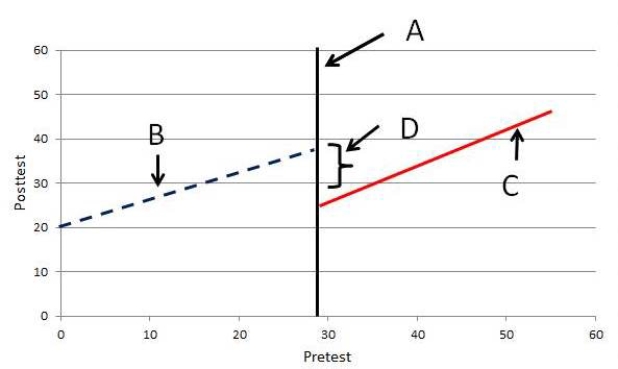
Consider the accompanying figure,illustrating the regression discontinuity design.What is shown by A?
A)regression line
B)cutoff
C)crossover
D)discontinuity

Consider the accompanying figure,illustrating the regression discontinuity design.What is shown by A?
A)regression line
B)cutoff
C)crossover
D)discontinuity

Unlock Deck
Unlock for access to all 70 flashcards in this deck.
Unlock Deck
k this deck
22
Figure TB 10-9

What design is shown in the accompanying figure?
A)double pretest
B)switching replications
C)nonequivalent dependent variables
D)regression point displacement

What design is shown in the accompanying figure?
A)double pretest
B)switching replications
C)nonequivalent dependent variables
D)regression point displacement

Unlock Deck
Unlock for access to all 70 flashcards in this deck.
Unlock Deck
k this deck
23
Narrative 10-1 -Daycare Center - Part I
Ken studies literacy and is particularly concerned about children who lag in reading readiness.He has developed a reading readiness program that can easily be implemented by day care providers in group settings,and has selected two day cares in demographically similar neighborhoods.He starts by giving a reading readiness to all of the three- and four-year-olds in both day care centers.
Figure TB 10-11
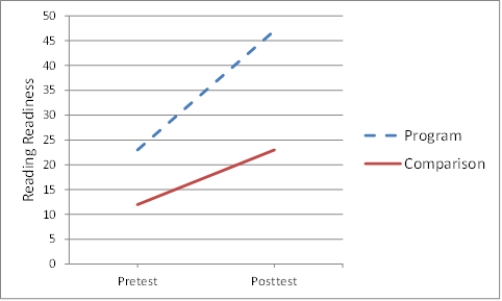
Ken decides to implement his intervention at one daycare but not the other,and after the intervention is complete,he administers the reading readiness test again to both groups of children.His results are shown in the accompanying figure.This figure most suggests the existence of a(n)____ threat.
A)instrumentation
B)testing
C)selection
D)diffusion
Ken studies literacy and is particularly concerned about children who lag in reading readiness.He has developed a reading readiness program that can easily be implemented by day care providers in group settings,and has selected two day cares in demographically similar neighborhoods.He starts by giving a reading readiness to all of the three- and four-year-olds in both day care centers.
Figure TB 10-11

Ken decides to implement his intervention at one daycare but not the other,and after the intervention is complete,he administers the reading readiness test again to both groups of children.His results are shown in the accompanying figure.This figure most suggests the existence of a(n)____ threat.
A)instrumentation
B)testing
C)selection
D)diffusion

Unlock Deck
Unlock for access to all 70 flashcards in this deck.
Unlock Deck
k this deck
24
Figure TB 10-6
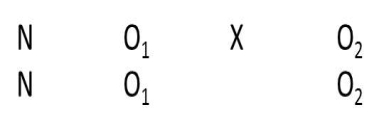
What type of design is shown in the accompanying figure?
A)non-equivalent groups
B)regression discontinuity
C)proxy-pretest
D)separate pre-post samples

What type of design is shown in the accompanying figure?
A)non-equivalent groups
B)regression discontinuity
C)proxy-pretest
D)separate pre-post samples

Unlock Deck
Unlock for access to all 70 flashcards in this deck.
Unlock Deck
k this deck
25
Narrative 10-1 -Daycare Center - Part I
Ken studies literacy and is particularly concerned about children who lag in reading readiness.He has developed a reading readiness program that can easily be implemented by day care providers in group settings,and has selected two day cares in demographically similar neighborhoods.He starts by giving a reading readiness to all of the three- and four-year-olds in both day care centers.
Figure TB 10-11

Ken decides to implement his intervention at one daycare but not the other,and after the intervention is complete,he administers the reading readiness test again to both groups of children.His results are shown in the accompanying figure.The performance of both of the groups improves over time,suggesting the operation of ____.
A)maturation
B)mortality
C)selection
D)diffusion
Ken studies literacy and is particularly concerned about children who lag in reading readiness.He has developed a reading readiness program that can easily be implemented by day care providers in group settings,and has selected two day cares in demographically similar neighborhoods.He starts by giving a reading readiness to all of the three- and four-year-olds in both day care centers.
Figure TB 10-11

Ken decides to implement his intervention at one daycare but not the other,and after the intervention is complete,he administers the reading readiness test again to both groups of children.His results are shown in the accompanying figure.The performance of both of the groups improves over time,suggesting the operation of ____.
A)maturation
B)mortality
C)selection
D)diffusion

Unlock Deck
Unlock for access to all 70 flashcards in this deck.
Unlock Deck
k this deck
26
Figure TB 10-10

What design is shown in the accompanying figure?
A)double pretest
B)switching replications
C)nonequivalent dependent variables
D)regression point displacement

What design is shown in the accompanying figure?
A)double pretest
B)switching replications
C)nonequivalent dependent variables
D)regression point displacement

Unlock Deck
Unlock for access to all 70 flashcards in this deck.
Unlock Deck
k this deck
27
From a methodological point of view,inferences drawn from a well-implemented regression-discontinuity design are ____ conclusions from randomized experiments.
A)superior in internal validity to
B)far less stable than
C)less strong than
D)comparable in internal validity to
A)superior in internal validity to
B)far less stable than
C)less strong than
D)comparable in internal validity to

Unlock Deck
Unlock for access to all 70 flashcards in this deck.
Unlock Deck
k this deck
28
Figure TB 10-8

What design is shown in the accompanying figure?double pretest
A)double pretest
B)switching replications
C)nonequivalent dependent variables
D)regression point displacement

What design is shown in the accompanying figure?double pretest
A)double pretest
B)switching replications
C)nonequivalent dependent variables
D)regression point displacement

Unlock Deck
Unlock for access to all 70 flashcards in this deck.
Unlock Deck
k this deck
29
Figure TB 10-3

What type of design is shown in the accompanying figure?
A)non-equivalent groups
B)regression discontinuity
C)proxy-pretest
D)separate pre-post samples

What type of design is shown in the accompanying figure?
A)non-equivalent groups
B)regression discontinuity
C)proxy-pretest
D)separate pre-post samples

Unlock Deck
Unlock for access to all 70 flashcards in this deck.
Unlock Deck
k this deck
30
Figure TB 10-7
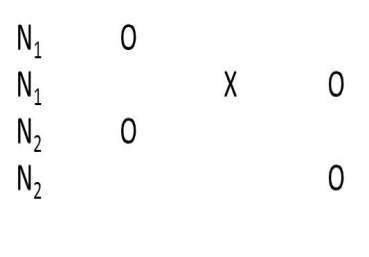
What type of design is shown in the accompanying figure?
A)non-equivalent groups
B)regression discontinuity
C)proxy-pretest
D)separate pre-post samples

What type of design is shown in the accompanying figure?
A)non-equivalent groups
B)regression discontinuity
C)proxy-pretest
D)separate pre-post samples

Unlock Deck
Unlock for access to all 70 flashcards in this deck.
Unlock Deck
k this deck
31
Narrative 10-2 -Daycare Center - Part II
Ken studies literacy and is particularly concerned about children who lag in reading readiness.He has developed a reading readiness program that can easily be implemented by day care providers in group settings,and has selected two day cares in demographically similar neighborhoods.Ken begins by giving a reading readiness to all of the three- and four-year-olds in both of the day cares.He then implements his intervention at one daycare but not the other,and after the intervention is complete,he administers the reading readiness test again to both groups of children.
Figure TB 10-13
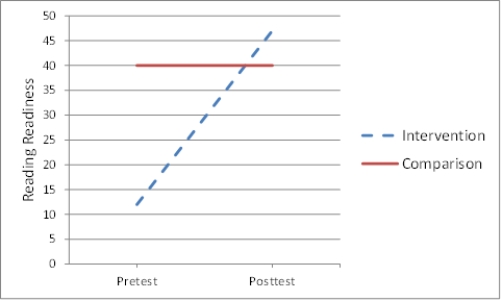
Ken's results are shown in the accompanying figure.What conclusion is most strongly supported by these results?
A)The intervention had no effect.
B)The intervention improved reading readiness.
C)Selection effects prevent any conclusions.
D)Regression effects prevent any conclusions.
Ken studies literacy and is particularly concerned about children who lag in reading readiness.He has developed a reading readiness program that can easily be implemented by day care providers in group settings,and has selected two day cares in demographically similar neighborhoods.Ken begins by giving a reading readiness to all of the three- and four-year-olds in both of the day cares.He then implements his intervention at one daycare but not the other,and after the intervention is complete,he administers the reading readiness test again to both groups of children.
Figure TB 10-13

Ken's results are shown in the accompanying figure.What conclusion is most strongly supported by these results?
A)The intervention had no effect.
B)The intervention improved reading readiness.
C)Selection effects prevent any conclusions.
D)Regression effects prevent any conclusions.

Unlock Deck
Unlock for access to all 70 flashcards in this deck.
Unlock Deck
k this deck
32
Figure TB 10-5
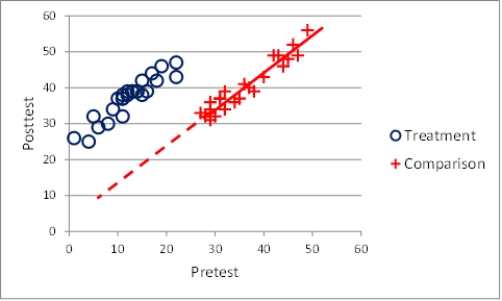
The graph in the accompanying figure indicates _____.
A)no treatment effect
B)a treatment interaction
C)an effect of treatment
D)confounding

The graph in the accompanying figure indicates _____.
A)no treatment effect
B)a treatment interaction
C)an effect of treatment
D)confounding

Unlock Deck
Unlock for access to all 70 flashcards in this deck.
Unlock Deck
k this deck
33
It is possible to mitigate the non-equivalency of groups in the NEGD by ____.
A)introducing at least two covariates
B)randomly assigning subjects to groups
C)choosing the treatment and control groups to be as similar to each other as possible
D)using as many measurement opportunities as possible
A)introducing at least two covariates
B)randomly assigning subjects to groups
C)choosing the treatment and control groups to be as similar to each other as possible
D)using as many measurement opportunities as possible

Unlock Deck
Unlock for access to all 70 flashcards in this deck.
Unlock Deck
k this deck
34
Narrative 10-1 -Daycare Center - Part I
Ken studies literacy and is particularly concerned about children who lag in reading readiness.He has developed a reading readiness program that can easily be implemented by day care providers in group settings,and has selected two day cares in demographically similar neighborhoods.He starts by giving a reading readiness to all of the three- and four-year-olds in both day care centers.
Figure TB 10-11

Ken decides to implement his intervention at one daycare but not the other,and after the intervention is complete,he administers the reading readiness test again to both groups of children.His results are shown in the accompanying figure.When Ken talks to reading specialists,he learns that children often progress slowly at first,but when their readiness skills reach a certain point,they seem to take off.Thus children who started at a higher level,like those in his intervention group,may improve faster than children who start off at a lower level,like his comparison group.Given this,it is possible that Ken's results reflect not his intervention,but rather,____ effects.
A)selection-maturation
B)selection-mortality
C)selection-regression
D)selection-diffusion
Ken studies literacy and is particularly concerned about children who lag in reading readiness.He has developed a reading readiness program that can easily be implemented by day care providers in group settings,and has selected two day cares in demographically similar neighborhoods.He starts by giving a reading readiness to all of the three- and four-year-olds in both day care centers.
Figure TB 10-11

Ken decides to implement his intervention at one daycare but not the other,and after the intervention is complete,he administers the reading readiness test again to both groups of children.His results are shown in the accompanying figure.When Ken talks to reading specialists,he learns that children often progress slowly at first,but when their readiness skills reach a certain point,they seem to take off.Thus children who started at a higher level,like those in his intervention group,may improve faster than children who start off at a lower level,like his comparison group.Given this,it is possible that Ken's results reflect not his intervention,but rather,____ effects.
A)selection-maturation
B)selection-mortality
C)selection-regression
D)selection-diffusion

Unlock Deck
Unlock for access to all 70 flashcards in this deck.
Unlock Deck
k this deck
35
Figure TB 10-2

What design is shown in the accompanying figure?
A)double pretest
B)switching replications
C)nonequivalent dependent variables
D)regression point displacement

What design is shown in the accompanying figure?
A)double pretest
B)switching replications
C)nonequivalent dependent variables
D)regression point displacement

Unlock Deck
Unlock for access to all 70 flashcards in this deck.
Unlock Deck
k this deck
36
Figure TB 10-4

The graph in the accompanying figure indicates _____.
A)no treatment effect
B)a treatment interaction
C)an effect of treatment
D)confounding

The graph in the accompanying figure indicates _____.
A)no treatment effect
B)a treatment interaction
C)an effect of treatment
D)confounding

Unlock Deck
Unlock for access to all 70 flashcards in this deck.
Unlock Deck
k this deck
37
Narrative 10-1 -Daycare Center - Part I
Ken studies literacy and is particularly concerned about children who lag in reading readiness.He has developed a reading readiness program that can easily be implemented by day care providers in group settings,and has selected two day cares in demographically similar neighborhoods.He starts by giving a reading readiness to all of the three- and four-year-olds in both day care centers.
Ken decides to implement his intervention at one daycare but not the other,and after the intervention is complete,he will administer the reading readiness test again to both groups of children.This design is a(n)____ design.
A)nonequivalent groups
B)separate pre-post
C)regression discontinuity
D)proxy-pretest
Ken studies literacy and is particularly concerned about children who lag in reading readiness.He has developed a reading readiness program that can easily be implemented by day care providers in group settings,and has selected two day cares in demographically similar neighborhoods.He starts by giving a reading readiness to all of the three- and four-year-olds in both day care centers.
Ken decides to implement his intervention at one daycare but not the other,and after the intervention is complete,he will administer the reading readiness test again to both groups of children.This design is a(n)____ design.
A)nonequivalent groups
B)separate pre-post
C)regression discontinuity
D)proxy-pretest

Unlock Deck
Unlock for access to all 70 flashcards in this deck.
Unlock Deck
k this deck
38
Narrative 10-2 -Daycare Center - Part II
Ken studies literacy and is particularly concerned about children who lag in reading readiness.He has developed a reading readiness program that can easily be implemented by day care providers in group settings,and has selected two day cares in demographically similar neighborhoods.Ken begins by giving a reading readiness to all of the three- and four-year-olds in both of the day cares.He then implements his intervention at one daycare but not the other,and after the intervention is complete,he administers the reading readiness test again to both groups of children.
Figure TB 10-12
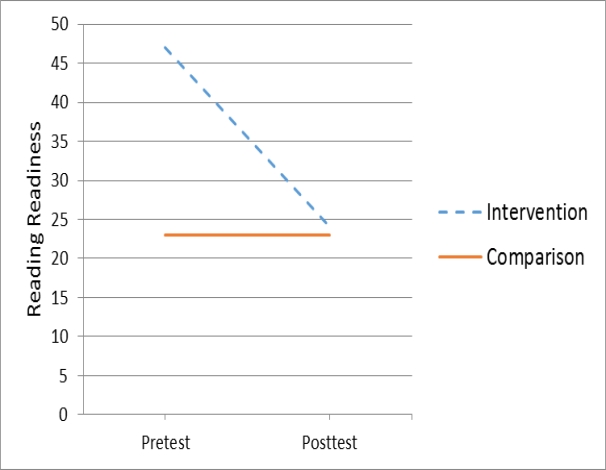
Ken's results are shown in the accompanying figure.What conclusion is most strongly supported by these results?
A)The intervention had no effect.
B)The intervention improved reading readiness.
C)Selection effects prevent any conclusions.
D)Regression effects prevent any conclusions.
Ken studies literacy and is particularly concerned about children who lag in reading readiness.He has developed a reading readiness program that can easily be implemented by day care providers in group settings,and has selected two day cares in demographically similar neighborhoods.Ken begins by giving a reading readiness to all of the three- and four-year-olds in both of the day cares.He then implements his intervention at one daycare but not the other,and after the intervention is complete,he administers the reading readiness test again to both groups of children.
Figure TB 10-12

Ken's results are shown in the accompanying figure.What conclusion is most strongly supported by these results?
A)The intervention had no effect.
B)The intervention improved reading readiness.
C)Selection effects prevent any conclusions.
D)Regression effects prevent any conclusions.

Unlock Deck
Unlock for access to all 70 flashcards in this deck.
Unlock Deck
k this deck
39
A design that includes two waves of measurement prior to the intervention is a ____ design.
A)double pretest
B)switching replications
C)nonequivalent dependent variables
D)regression point displacement
A)double pretest
B)switching replications
C)nonequivalent dependent variables
D)regression point displacement

Unlock Deck
Unlock for access to all 70 flashcards in this deck.
Unlock Deck
k this deck
40
Figure TB 10-4

The graph in the accompanying figure was most likely generated by a study using the ____ design.
A)non-equivalent groups
B)regression discontinuity
C)proxy-pretest
D)separate pre-post samples

The graph in the accompanying figure was most likely generated by a study using the ____ design.
A)non-equivalent groups
B)regression discontinuity
C)proxy-pretest
D)separate pre-post samples

Unlock Deck
Unlock for access to all 70 flashcards in this deck.
Unlock Deck
k this deck
41
In the archived proxy-pretest design,the pretest is based on ____.
A)standardized test norms
B)pre-existing records for study participants
C)expected averages
D)informant recollections
A)standardized test norms
B)pre-existing records for study participants
C)expected averages
D)informant recollections

Unlock Deck
Unlock for access to all 70 flashcards in this deck.
Unlock Deck
k this deck
42
A regression point displacement design is particularly attractive when ____.
A)the researcher is evaluating a program that has already begun
B)the unit of study is a community rather than an individual
C)it is important that those who most need the treatment receive it
D)there are concerns about selection-maturation effects
A)the researcher is evaluating a program that has already begun
B)the unit of study is a community rather than an individual
C)it is important that those who most need the treatment receive it
D)there are concerns about selection-maturation effects

Unlock Deck
Unlock for access to all 70 flashcards in this deck.
Unlock Deck
k this deck
43
Figure TB 10-14

Consider the accompanying figure,illustrating the regression discontinuity design.What is shown by B?
A)regression line
B)cutoff
C)crossover
D)discontinuity

Consider the accompanying figure,illustrating the regression discontinuity design.What is shown by B?
A)regression line
B)cutoff
C)crossover
D)discontinuity

Unlock Deck
Unlock for access to all 70 flashcards in this deck.
Unlock Deck
k this deck
44
A proxy-pretest design is most likely to be used when ____.
A)the researcher is evaluating a program that has already begun
B)the unit of study is a community rather than an individual
C)it is important that those who most need the treatment receive it
D)there are concerns about selection-maturation effects
A)the researcher is evaluating a program that has already begun
B)the unit of study is a community rather than an individual
C)it is important that those who most need the treatment receive it
D)there are concerns about selection-maturation effects

Unlock Deck
Unlock for access to all 70 flashcards in this deck.
Unlock Deck
k this deck
45
The _______________ design allows the researcher to give the intervention to those who need it the most,based on the use of cut-off scores.

Unlock Deck
Unlock for access to all 70 flashcards in this deck.
Unlock Deck
k this deck
46
Research designs that have several of the key features of randomized experimental designs,such as pre-post measurement and treatment-control group comparisons,but lack random assignment to a treatment group are called _______________ designs.

Unlock Deck
Unlock for access to all 70 flashcards in this deck.
Unlock Deck
k this deck
47
Any factor other than the program that leads to posttest differences between groups is termed a(n) _______________.

Unlock Deck
Unlock for access to all 70 flashcards in this deck.
Unlock Deck
k this deck
48
The degree of correspondence between two data items is referred to as _______________.

Unlock Deck
Unlock for access to all 70 flashcards in this deck.
Unlock Deck
k this deck
49
The threat to internal validity that occurs when there are different rates of movement towards the mean in the two groups is termed a(n)_______________ threat.

Unlock Deck
Unlock for access to all 70 flashcards in this deck.
Unlock Deck
k this deck
50
Figure TB 10-14

Consider the figure above,illustrating the regression discontinuity design.What can you conclude?
A)The treatment had an effect,as shown by the discontinuity at the cutoff.
B)There appears to be a selection effect,because the groups differed before the treatment began.
C)The slopes of the regression lines appear similar, so there is no treatment effect.
D)The discontinuity suggests the presence of a maturation effect.

Consider the figure above,illustrating the regression discontinuity design.What can you conclude?
A)The treatment had an effect,as shown by the discontinuity at the cutoff.
B)There appears to be a selection effect,because the groups differed before the treatment began.
C)The slopes of the regression lines appear similar, so there is no treatment effect.
D)The discontinuity suggests the presence of a maturation effect.

Unlock Deck
Unlock for access to all 70 flashcards in this deck.
Unlock Deck
k this deck
51
A group,comparable to the program group,that did not receive the program,is called a(n)_______________ group.

Unlock Deck
Unlock for access to all 70 flashcards in this deck.
Unlock Deck
k this deck
52
Figure TB 10-14

Consider the accompanying figure,illustrating the regression discontinuity design.What is shown by D?
A)regression line
B)cutoff
C)crossover
D)discontinuity

Consider the accompanying figure,illustrating the regression discontinuity design.What is shown by D?
A)regression line
B)cutoff
C)crossover
D)discontinuity

Unlock Deck
Unlock for access to all 70 flashcards in this deck.
Unlock Deck
k this deck
53
Figure TB 10-14

Consider the accompanying figure,illustrating the regression discontinuity design.What is shown by C?
A)regression line
B)cutoff
C)crossover
D)discontinuity

Consider the accompanying figure,illustrating the regression discontinuity design.What is shown by C?
A)regression line
B)cutoff
C)crossover
D)discontinuity

Unlock Deck
Unlock for access to all 70 flashcards in this deck.
Unlock Deck
k this deck
54
The branch of mathematics dealing with the collection,analysis,interpretation,and presentation of quantitative data is _______________.

Unlock Deck
Unlock for access to all 70 flashcards in this deck.
Unlock Deck
k this deck
55
In the _______________ design,the pretest is collected after the program is given.

Unlock Deck
Unlock for access to all 70 flashcards in this deck.
Unlock Deck
k this deck
56
A line that describes the relationship between two or more variables is termed a(n)_______________ line.

Unlock Deck
Unlock for access to all 70 flashcards in this deck.
Unlock Deck
k this deck
57
A double pretest design is particularly attractive when ____.
A)the researcher is evaluating a program that has already begun
B)the unit of study is a community rather than an individual
C)it is important that those who most need the treatment receive it
D)there are concerns about selection-maturation effects
A)the researcher is evaluating a program that has already begun
B)the unit of study is a community rather than an individual
C)it is important that those who most need the treatment receive it
D)there are concerns about selection-maturation effects

Unlock Deck
Unlock for access to all 70 flashcards in this deck.
Unlock Deck
k this deck
58
A regression-discontinuity design is particularly attractive when ____.
A)the researcher is evaluating a program that has already begun
B)the unit of study is a community rather than an individual
C)it is important that those who most need the treatment receive it
D)there are concerns about selection-maturation effects
A)the researcher is evaluating a program that has already begun
B)the unit of study is a community rather than an individual
C)it is important that those who most need the treatment receive it
D)there are concerns about selection-maturation effects

Unlock Deck
Unlock for access to all 70 flashcards in this deck.
Unlock Deck
k this deck
59
What design is sometimes referred to as a dry run quasi-experimental design because it simulates what would happen were there no effect of the treatment?
A)NEDV
B)regression-discontinuity
C)double pretest
D)NEGD
A)NEDV
B)regression-discontinuity
C)double pretest
D)NEGD

Unlock Deck
Unlock for access to all 70 flashcards in this deck.
Unlock Deck
k this deck
60
The most commonly used quasi-experimental design is the _______________ design.

Unlock Deck
Unlock for access to all 70 flashcards in this deck.
Unlock Deck
k this deck
61
In the recollection or _______________ proxy-pretest design,participants are asked to recall their characteristics in the past.

Unlock Deck
Unlock for access to all 70 flashcards in this deck.
Unlock Deck
k this deck
62
How does the switching-replications design enhance generalizability?

Unlock Deck
Unlock for access to all 70 flashcards in this deck.
Unlock Deck
k this deck
63
Describe the two forms of the proxy-pretest design.

Unlock Deck
Unlock for access to all 70 flashcards in this deck.
Unlock Deck
k this deck
64
Describe the pattern-matching NEDV design.

Unlock Deck
Unlock for access to all 70 flashcards in this deck.
Unlock Deck
k this deck
65
The _______________ design is particularly useful in community-based research,because only one unit receives the intervention.

Unlock Deck
Unlock for access to all 70 flashcards in this deck.
Unlock Deck
k this deck
66
In its simple form,the _______________ design is very weak with respect to internal validity.

Unlock Deck
Unlock for access to all 70 flashcards in this deck.
Unlock Deck
k this deck
67
In the _______________ design,it is possible to determine whether the intervention and comparison groups are maturing at different rates.

Unlock Deck
Unlock for access to all 70 flashcards in this deck.
Unlock Deck
k this deck
68
How does the double-pretest design address selection-maturation threats?

Unlock Deck
Unlock for access to all 70 flashcards in this deck.
Unlock Deck
k this deck
69
Why is the regression point displacement design so useful in assessing the impact of community interventions?

Unlock Deck
Unlock for access to all 70 flashcards in this deck.
Unlock Deck
k this deck
70
In the _______________ design,the people used for the pretest are not the same as the people used for the posttest.

Unlock Deck
Unlock for access to all 70 flashcards in this deck.
Unlock Deck
k this deck



